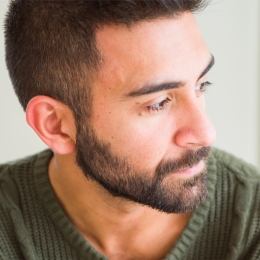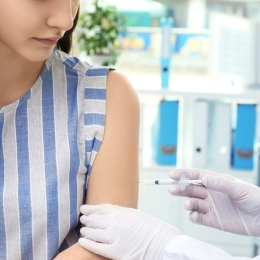What to know about skin cancer
“Almost everybody knows somebody who has had skin cancer,” says Vishal Anil Patel, director of the cutaneous oncology program at the George Washington University Cancer Center. Though most of those cancers aren’t dangerous, some can be deadly. Here’s what to know...and how to protect yourself.
Not all skin cancers are alike. “We traditionally lump them into melanoma or non-melanoma,” says Patel.
Melanoma skin cancer
Melanoma is a cancer of the melanocytes, the pigment-producing cells of the skin, and it can be tricky to detect. Most look like a changing mole (see “The ABCDEs of Melanoma”), but others can look like a bruise, a vertical dark line under a fingernail, or an age spot.
Melanoma is the most dangerous type of skin cancer. Roughly 98,000 cases will be diagnosed in 2023, and some 8,000 people will die of the disease.
The good news: If melanoma is caught before it spreads to the lymph nodes (and roughly 80 percent of the time, it is), the five-year survival rate is nearly 100 percent.
The bad news: If the cancer has spread to distant lymph nodes, only about 35 percent of patients survive for five years.
(That said, deaths due to melanoma fell roughly 25 percent between 2011 and 2020, largely thanks to new treatments.)
What makes melanoma so dangerous?
“Even small lesions or lesions that are fairly new can break off and travel to distant lymph nodes and grow more aggressively,” says Patel.
“It’s difficult to predict how melanoma is going to behave.”
Non-melanoma skin cancer
“On the non-melanoma side, there are basal cell and squamous cell skin cancers,” says Patel. Basal and squamous cells are two types of keratinocytes, the most abundant type of skin cells that make up the outermost layer of skin.
“We estimate that between one and four million people are diagnosed with non-melanoma skin cancer each year,” says Patel.
Basal cell cancers often look like a raised nodule that is pink, red, or pearly. Sometimes they resemble a flat scar with a waxy look. Squamous cell cancers are often thick, scaly, or crusty patches or they might resemble a wart.
“Non-melanoma skin cancers typically grow slowly and locally,” says Patel.

“They can get bigger and cause local destruction, though most tumors are not a problem if caught early. But if someone doesn’t receive timely care, those tumors may move into the lymph nodes and become a problem.”
Basal cell cancer has an extremely low risk of spreading to other parts of the body, notes Patel. “But squamous cell cancer has a higher potential of spreading.”
Only 3 to 5 percent of squamous cell cancers will spread, and 1 to 2 percent of patients will die. But because squamous cell cancers are so common, they kill about as many Americans each year as melanoma.
Know your risk
We aren’t all at equal risk of getting skin cancer. People with weakened immune systems or those with a family history of skin cancer are at higher risk, Patel explains. Here’s what else matters:
Skin tone
People with lighter skin tones that freckle or burn easily, red or blond hair, or blue or green eyes have a higher risk of developing all types of skin cancer. White people are 30 times more likely to get melanoma than Black people.
“If you have darker skin, you’re more protected,” says Patel. “Darker-skinned people can still develop skin cancer, but it’s rare.” That’s because melanin, the pigment made by melanocytes, acts as a natural sunblock.
“When melanoma occurs in Black, Indian, Asian, and other darker-skinned populations, it tends to be on the palms of the hands, the soles of the feet, or under the nails,” says Patel.
(Unlike other melanomas, those “acral” melanomas are less likely to be caused by ultraviolet light.)
Though there’s no strong evidence that sunscreen lowers the risk of skin cancer if you have dark skin, it’s worth using to play it safe...and to prevent sunburn and wrinkles. And even though your risk is lower if you have dark skin, you shouldn’t ignore a suspicious mole, spot, or lesion. Melanoma is often diagnosed in people with darker skin at later stages, when the disease is more advanced and survival rates are lower.
Ultraviolet light
“UV radiation is the most important modifiable risk factor linked to skin cancer,” says Patel.
UVA rays penetrate the deep layers of skin and cause skin aging and wrinkles, while UVB is primarily responsible for sunburns. Both cause skin cancer.
“Basal and squamous cell cancers are directly linked to how much UV radiation you’ve had,” says Patel. In other words, the higher your cumulative lifetime exposure to UV light, the higher your risk. Having had more sunburns also puts you at greater risk.
In contrast, “the risk of melanoma is more linked to the amount of high intensity sun exposure, especially in childhood,” notes Patel. “Think of blistering or intense sunburns, not simply how much exposure you’ve had.”
Tanning beds
They give off UV rays, so it’s no surprise that the use of tanning beds has been linked to an increased risk of melanoma, especially in people who start before age 30.
Precancerous lesions
Actinic keratosis—a type of “precancerous lesion”—can feel like a small patch of scaly skin that may be red, tan, or pink.
“We used to think that precancerous lesions turn into squamous cell cancer,” says Patel. But most don’t.
However, “if you have a lot of actinic keratoses, you’re at a higher risk of developing non-melanoma skin cancer somewhere on your body,” he adds.
“Much like if you have clogged arteries, you are at risk for a heart attack and you may need to lower your cholesterol, lower your blood pressure, and so on. Similarly, when we see precancerous lesions, we want to lower your overall skin cancer risk.”
That means practicing safe sun habits. And, if necessary, your doctor will treat areas on your skin that have suffered extensive sun damage.
Moles
People with many small—or several large—moles have a greater risk of melanoma. Ditto for those who have had a dysplastic nevus (an atypical mole), which often looks like something between a normal mole and melanoma.
The ABCDEs of melanoma
Most moles are harmless. But ones that are new, changing, or unusual may spell trouble. Here’s what to look for.

- A is for asymmetry. The two halves don’t match.
- B is for border. The mole has an irregular border.
- C is for color. The spot has varying colors.
- D is for diameter. The mole is wider than a pencil eraser.
- E is for evolving. Any change in size, color, or shape could be a warning sign. Here, the bottom right section shows a melanoma growing from a mole (upper left section).
Getting checked
Should you get a regular skin check for skin cancer?
In April, the U.S. Preventive Services Task Force concluded that there’s not enough evidence to recommend total body skin exams to prevent skin cancer in people who aren’t at high risk.
Why not? There’s no good evidence that skin exams lower the risk of dying from melanoma. Instead, screening may simply lead to overdiagnosis—that is, a surge in diagnosing and treating cancers that were never going to cause harm.
Melanoma diagnoses have jumped roughly six-fold in the last 40 years, though the drop in deaths seen over the past decade or so is largely due to better treatments, not improved screening.
“That jump in diagnoses can make it look like melanoma is becoming a bigger problem, but it might be that we’re just looking more closely for it,” Patel notes.
Whatever the case, melanomas can be deadly, so if you’re at high risk or if you’ve had skin cancer before, see your dermatologist regularly.
“And if you have an atypical lesion—meaning something that’s new that you don’t recognize that is changing, growing, bleeding, not healing, not going away, or looks different than your other spots—you need to have that evaluated,” says Patel.
Protect yourself
To lower your risk of sunburn, skin aging, and skin cancer, “utilize a variety of sun-protective behaviors,” says Aaron Farberg, a clinical assistant professor at the University of North Texas Health Science Center and a dermatologist at Bare Dermatology. That includes:
Timing
“Seek shade and cover up when the sun is brightest, usually between 10 a.m. and 2 p.m.,” says Farberg. That’s when UVB radiation is strongest.
UVA radiation, on the other hand, is fairly constant throughout the daylight hours, so you need to protect your skin even in the early morning or late afternoon.
And short spurts add up. “Sun exposure from daily activities—walking to and from the car, running errands—accumulates over time and increases your risk for skin cancer,” notes Farberg.
Shade
Seek shade when you can, even though that’s not a slam-dunk protector.
“We did a study where we had people sit under a beach umbrella for three and a half hours, and about 80 percent of them still got a sunburn,” says Farberg. (The study was funded in part by—and co-authored by employees of—Johnson & Johnson, which makes sunscreen products.)
Why wasn’t the shade enough? “The sunlight is bouncing around and hitting you from multiple angles,” Farberg explains.
And you can’t assume that clouds provide shade. Up to 80 percent of UV light penetrates through light cloud cover.
A good rule of thumb is to protect your skin whenever the UV Index (available on most weather apps) is 3 or higher (the scale goes from 0 to 11+).
Clothing
Sunglasses that block at least 99 percent of UV rays (or that are labeled UV400) and a wide-brimmed hat are essential components of any sun-protection toolkit. And dark-colored or tightly woven fabrics like denim, polyester, and wool provide more protection than light-colored or looser-woven fabrics like linen and most cotton.
You can also look for clothes with UPF—ultraviolet protection factor. A UPF 50+ rating means that a fabric lets in less than 2 percent of UV rays.
“The technology of sun-protective clothing has improved drastically,” says Farberg. “You can be in a long sleeve shirt and pants when it’s 100 degrees, and you’ll be cooler than if you were wearing a T-shirt.”
Windows
“Regular glass will block UVB rays,” says Farberg. And most windshields—but not side or back car windows—also block UVA light. “You can get tints that don’t necessarily darken those windows but will block UVA radiation.”
SPF

“Use water-resistant broad spectrum sunscreen with an SPF of 30 or higher, applied in a liberal fashion,” says Farberg.
An SPF (sun protection factor) of 30 blocks 97 percent of UVB rays. SPF 100 blocks 99 percent. There’s no SPF rating for UVA, though “broad spectrum” sunscreens guarantee at least some protection against it.
Is it worth buying a higher SPF sunscreen? It depends.
“Most people do not apply enough sunscreen,” says Farberg. In general, you should use about a shot glass’s worth of sunscreen for your whole body. But studies show that people typically only use 20 to 50 percent as much as they should.
“So using a higher SPF provides an extra margin of safety,” says Farberg.
Just don’t use that higher SPF as an excuse to be lax about other sun safety practices.
And don’t forget to reapply sunscreen every couple of hours and after sweating or swimming. “You’ll get some extra coverage,” says Farberg, “but you’ll also hit areas that you may have missed the first time around.”
Spray or lotion?
“The best sunscreen is the one that you’ll use,” says Farberg.
“Lotion is probably the most effective because you can see where you’ve applied it. But some people just apply a small amount and spread it very thinly.”
Prefer a spray? “You have to spray on a large amount, and you need to rub it in,” says Farberg.
To avoid inhaling sprays, use them only in a well-ventilated area. And don’t spray your face. Instead, spray your palms, then rub the sunscreen into your face.
Chemical or mineral sunscreen?
In 2020, the FDA found that six chemicals commonly used in sunscreens—avobenzone, homosalate, octinoxate, octisalate, octocrylene, and oxybenzone—can be absorbed into the bloodstream. That doesn’t necessarily mean they’re dangerous, but the FDA has asked companies for more safety data.
Mineral sunscreens (which use zinc oxide and titanium dioxide to block UV rays) aren’t absorbed and are considered safe and effective by the FDA. But tests earlier this year by Consumer Reports found that mineral sunscreens provided only about 15 to 60 percent of the labeled SPF. The magazine said that it hadn’t found a mineral sunscreen that provides top-notch coverage (though its tests show that many chemical sunscreens also don’t live up to their labeled SPF).
Expired sunscreen
“If you’re using enough, a bottle shouldn’t last more than a season,” says Farberg.
What if it’s past the expiration date?
“You’re probably better off buying a new bottle,” he says. And if it separates into clumps when you squirt it out, it’s time for a new bottle, no matter when you bought it.
Tags
Topics
Continue reading this article with a NutritionAction subscription
Already a subscriber? Log in
More on cancer
A snapshot of the latest research on diet, exercise, and more
Preventing Disease

Colorectal cancer: 5 ways to cut your risk
Preventing Disease

Take our quiz to help you stay healthy
Preventing Disease

Is there a risk of cancer from ultra-processed foods?
Preventing Disease

A vaccine that prevents cervical cancer
Preventing Disease


